Pentidotea resecata (Stimpson, 1857)Common name: Concave isopod, eelgrass isopod, cut-tailed isopod, seaweed isopod, kelp isopod, transparent isopod |
|
| Synonyms: Idotea resecata, Idothea resecata | 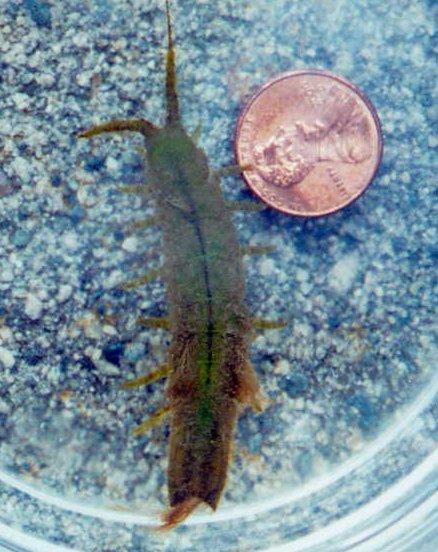 |
| Phylum Arthropoda
Subphylum Crustacea Class Malacostraca Subclass Eumalacostraca Superorder Peracarida Order Isopoda Suborder Valvifera Family Idoteidae |
|
| Pentidotea resecata about 5 cm long found by Heidee Leno at Shannon Point. The brown stringy growth seen at several places on the body is chains of diatoms attached to the cuticle. | |
| Photo taken by Heidee Leno, July 2002 | |
How to Distinguish from Similar Species: According to Kozloff's key, no other local isopod has a concave posterior margin to its pleotelson. However, Rafi and Laubitz (1990) state that another species with a concave pleotelson, Idotea rufescens, can be found from southeast Alaska to the Strait of Juan de Fuca. The two species can be distinguished by the fact that I. rufescens has only 4 segments on the palp of its maxilliped and the corners of the posterior pleotelson are rounded, while P. resecata has 5 segments on the palp of its maxilliped (as an adult) and the corners of the posterior pleotelson are more sharply pointed.
Habitat and Geographical Range: Pentidotea resecata generally appear from Alaska to the tip of Baja California and Mazatlan (Mexico). They prefer to be among eelgrass (Zostera) or kelps (Macrocystis and Pelagophycus).
Depth Range: Intertidal to 18 m
Biology/Natural History: When placed
on a substratum, the isopod will reorient itself along the long axis of
its substratum and if placed otherwise, it immediately reorients itself.
P.
resecata prefers to feed on algae such as Macrocystis,
Pelagophycus
porra, Eisenia arborea, Pterygophora californica, and
Egregia
laevigata, or on eelgrass (Zostera). Those found on kelp
are almost always brown, while those found on eelgrass are green. The brown
coloration is due to the exoskeleton, and the green coloration is due to
a combination of the exoskeleton and the green hemolymph. These animals
appear to be temperature and salinity sensitive. A temperature of 15 degress
Celsius is an optimum temperature for P. resecata.in California.
If temperatures reach between 29 and 31 degrees Celsius, the animal will
die. If the isopod is placed in fresh water it survives a little
over an hour in comparison with 33 hours in 125% seawater. Development
of these isopods is a bit unclear, but studies show that the general body
form changes little during growth. Features such as segment number
and setae
number vary directly with size, each molt providing further change. Juveniles
have a convex tip to the pleotelson
when released from the mother, but develop the distinctive concave tip
on later molts. The species blends in with the kelp or eelgrass that it
is on, and can also swim well using its first three pleopods.
It is a faster swimmer (about 0.2m/sec) than its congener Pentidotea
wosnessenskii is (Anderson and Chen, 1990). The last two pleopods
are used for respiration (breathing).
| Return to: | |||
| Main Page | Alphabetic Index | Systematic Index | Glossary |
References:
Dichotomous Keys:
Flora
and Fairbanks, 1966 (as Idothea (Pentidotea)
resecata)
Kozloff,
1987, 1996
Smith
and Carlton, 1975
General References:
Johnson
and Snook, 1955 (as Pentidotea resecata)
Kozloff,
1993
Lamb
and Hanby, 2005
Morris
et al., 1985
O'Clair
and O'Clair, 1998
Ricketts
et al., 1985
Scientific Articles:
Alexander, David E., Jeffrey Blodig, and Shiu-Yie Hsieh, 1995. Relationship between function and mechanical properties of the pleopods of isopod crustaceans. Invertebrate biology 114:2 pp 169-179
Alexander, David E. and Tao Chen, 1990. Comparison of swimming speed and hydrodynamic drag in two species of Idotea (Isopoda). Journal of Crustacean Biology 10:3 pp. 406-412. doi.org/10.2307/1548330
Anderson, Sarah J., Faith E. Hunnicutt, and David L. Cowles, 2017. Activity levels of Pentidotea resecata support conclusion that the animal is photosynthetic. Poster presented at ASLO Aquatic Sciences Meeting, Honolulu, HI
Cowles, Joanna M., 2015. Does photosynthesis take place in the gut of Pentidotea resecata? M.S. thesis, Walla Walla University
Cowles, Joanna M. and David L. Cowles, 2015. Photosynthesis and the green isopod Pentidotea resecata. Poster at SICB annual meeting, West Palm Beach, FL.
Cowles, J.M., N. Sullivan, D.L. Cowles, and G. Stone, 2011. Is the isopod Pentidotea resecata photosynthetic? Poster for Murdock Scientific Conference, Seattle, WA.
Dann, Leah E., 2017. Antioxidant capacity in the hemolymph of the marine isopod Pentidotea resecata. M.S. thesis, Walla Walla University
Dann, Leah E., C. Judelle Johnson, and David L. Cowles, 2017. Does Pentidotea resecata hemolymph protect the isopod from oxidative stress? Poster presented at ASLO Aquatic Sciences Meeting, Honolulu, HI
Hunnicutt, Faith E., Sarah J. Anderson, and David L. Cowles, 2016. Where do all the isopods go? A population study of Pentidotea resecata. Poster at Murdock Conference, Spokane, WA, November 2016
Johnson, C. Judelle, 2017. How does the green eelgrass isopod Pentidotea resecata protect its tissue against highly fluctuating oxygen conditions? M.S. thesis, Walla Walla University
Johnson, C. Judelle, Leah E. Dann, and David L. Cowles, 2017. How does the green eelgrass isopod protect its tissue against highly fluctuating oxygen conditions? Poster presented at ASLO Aquatic Sciences Meeting, Honolulu, HI
Jones, L.G., 1971. Studies on selected small herbivorous invertebrates inhabiting Macrocystis canopies and holdfasts in southern California kelp beds. pp. 343-367 in W.J. North (ed.), The biology of giant kelp beds (Macrocystis) in California. Verlag von J. Cramer, Lehre, Germany.
Lee, W. L. and B. M. Gilchrist, 1972. Pigmentation, color change, and the ecology of the marine isopod Idotea resecata (Stimpson, 1857). Journal of Experimental Mararine Biology and Ecology 10: 1-27
McLarty, Shelley J., 2015. Gut content and pigment analysis in the marine isopod Pentidotea resecata. M.S. thesis, Walla Walla University
McLarty, Shelley J. and David L. Cowles, 2015. Gut content and pigment analysis in the marine isopod Pentidotea resecata. Poster at SICB annual meeting, West Palm Beach, FL
McCluskey, Richard Laverne, 1966. Dietary regulation of growth and mortality in the isopod, Idotea resecata (Stimpson). Master's thesis, Walla Walla College. 23 pp.
Menzies, R.J. and R.J. Waidzunas, 1948. Post-embryonic growth changes in the isopod Pentidotea resecata (Stimpson) with remarks on their taxonomic significance. Biological Bulletin 95: 107-113
Rafi, F., and Diana R. Laubitz, 1989. The Idoteidae (Crustacea: Isopoda:
Valvifera) of the shallow waters of the northeastern North Pacific ocean.
Canadian Journal of Zoology 68: pp2649-2687
General Notes and Observations: Locations, abundances, unusual behaviors, etc.:
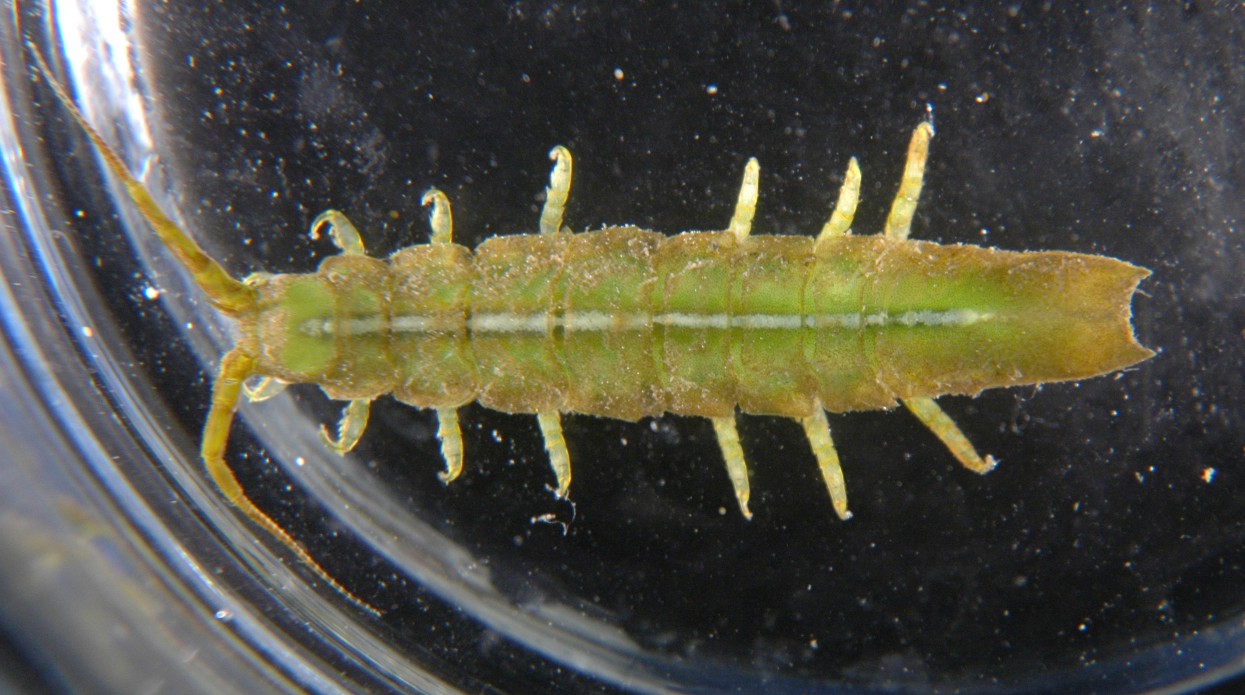
This male, 5 cm long not counting antennae, was found clinging to eelgrass
in Padilla Bay. Note that this individual, from eelgrass, is greener
than is usually seen in individuals which are feeding on brown algae.
Males often have a prominent greenish stripe (or greenish-white in this
indvidual) down the dorsal side. Photo by Dave Cowles, July 2008
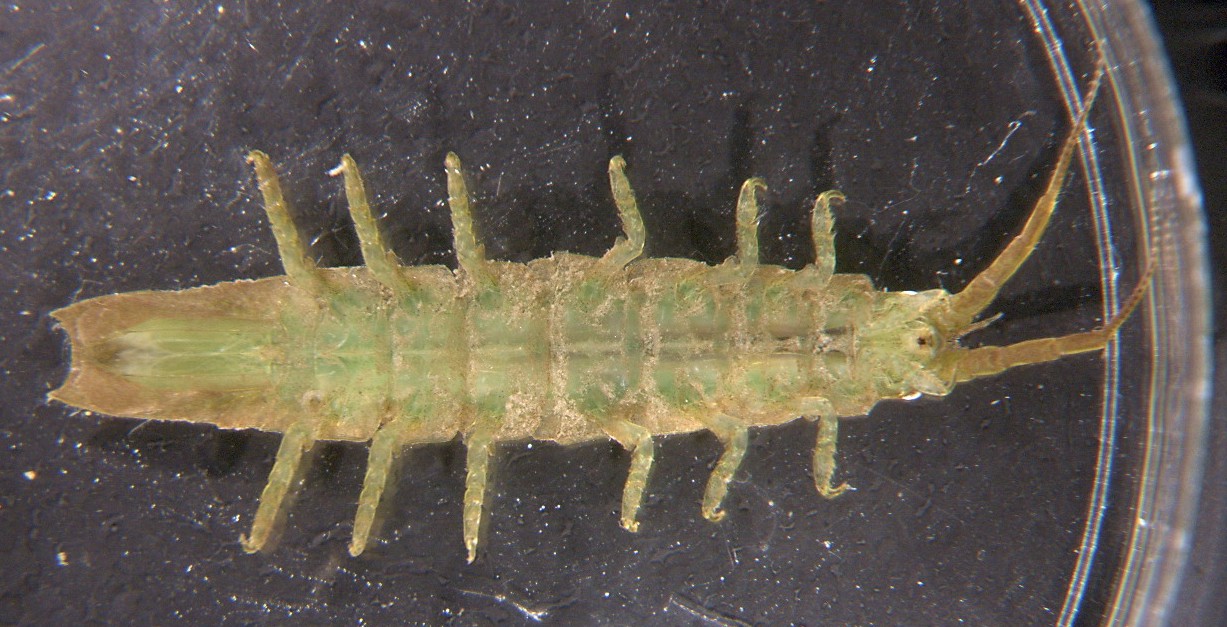
This underside view of the same male as the above photo shows the flaplike
uropods
which enclose the pleopods on the ventral side of the pleon
(to the left). Photo by Dave Cowles, July 2008
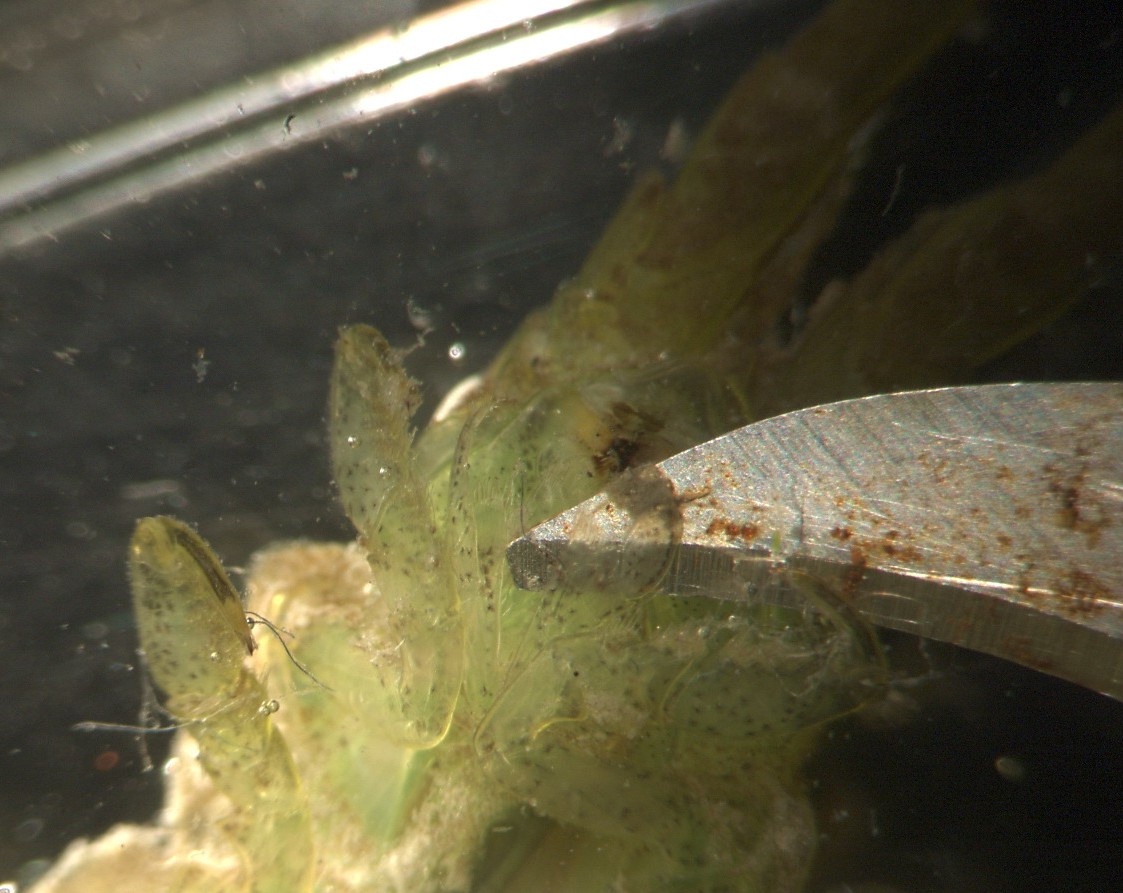
In this photograph of the mouthparts, the scalpel is holding out the
maxilliped.
The main, subchelate
branch of the maxilliped
can be seen just below and partly overlapping the scalpel blade.
The maxilliped
palp,
which has 5 articles
(difficult to count in this photo), crosses the scalpel blade in front
of the brown blotch. The darkened, sclerotized mandibles
can be seen just above and to the left of the scalpel blade. Photo
by Dave Cowles, July 2008
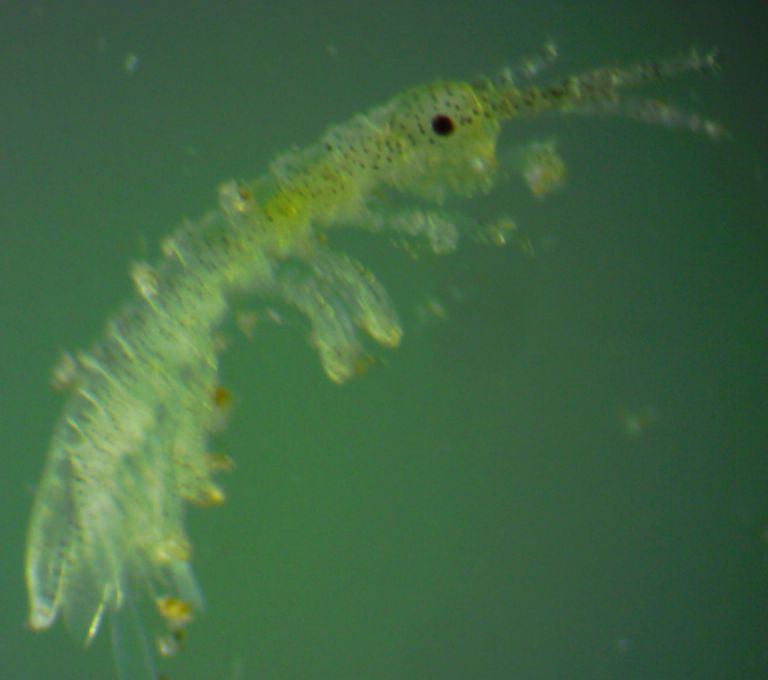
This baby, 3 mm long, was taken from the marsupium
of a mother who died. There were many more babies in the marsupium.
At this early stage the pleotelson
is still convex. Photo by Dave Cowles, August 3, 2016
Authors and Editors of Page:
Created original page: Heidee Leno
Edited by: Hans Helmstetler 11-2002; Dave Cowles 2008, 2012-
CSS coding for page developed by Jonathan Cowles
Salish Sea Invertebrates web site provided courtesy of Walla
Walla University